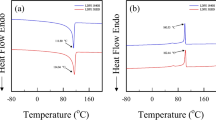Abstract
The effect of temperature and cyclic frequency on fatigue crack propagation (FCP) rates were investigated for poly methylmethacrylate (PMMA). Test temperature ranged from −30 to 100° C which includes theβ transition and approachesT g. FCP experiments were conducted at frequencies of 1, 10, 50 and 100 Hz. In general, the FCP rates increased with increasing temperature and decreasing cyclic frequency. The crack growth rate is near a maximum at 80° C and 10 Hz. When the experimental conditions approach the glass transition region, e.g. studies at 100° C, the failure mechanism changes and the material becomes more fatigue resistant while simultaneously softening. The frequency dependence ofda/dN provided by the Michel-Manson (M-M) model is shown to be valid up to about 80° C, in absence of extensive plastic deformation. FCP results exhibit an interaction between the thermal and mechanical driving forces which is not consistent with the M-M model.
Plots of FCP rate were made against the reciprocal of temperature. The apparent activation energies calculated from these plots varied from 13 to 44 kJ mol−1, and show that the activation energy increases as Δ/K increases and as cyclic frequency decreases.
Similar content being viewed by others
References
R. W. Hertzberg andJ. A. Manson, “Fatigue of Engineering Plastics”, (Academic Press, New York, 1980).
Idem, “Fatigue and Fracture”, Encyclo. Polymer Sci. Eng., Vol. 6, 2nd edn (J. Wiley, New York, 1986).
W.-M. Cheng, J. A. Manson, R. W. Hertzberg, G. A. Miller andL. H. Sperling,ACS Polym. Mat. Sci. Eng. in press.
J. D. Phillips, M. S. Thesis, Lehigh University, 1987.
R. W. Hertzberg, M. D. Skibo andJ. A. Manson. ASTM STP 700, 1980.
R. W. Lang, M. T. Hahn, R. W. Hertzberg andJ. A. Manson, ASTM STP 833 1984.
M. T. Hahn, R. W. Hertzberg andJ. A. Manson.J. Mater. Sci. 21 (1986) 31.
J. C. Michel, J. A. Manson andR. W. Hertzberg,Polym. Prepr., ACS Div. Polym. Chem. 26(2) (1985) 141.
J. C. Michel PhD dissertation, Lehigh University, 1984.
R. W. Hertzberg, J. A. Manson andM. D. Skibo,Polymer 19 (1978) 358.
R. Schirrer,J. Mater. Sci. 22 (1987) 2289.
R. Seldon,Polym. Testing 7 (1987) 209.
L. H. Lee, J. F. Mandell andF. J. McGarry,Polym. Eng. Sci. 27(15) (1987) 1128.
F. Zandman, “Etude de la Deformation et de la Pupture des Matieres Plastiques”, Publications Scientifique et Technique du Ministere de l'Air, No. 291, Paris, 1954.
I. Wolock, J. A. Kies andS. B. Newman, “Fracture”, edited by B. L. Averbach, D. K. Felbeck, G. T. Hahn and D. A. Thomas (Wiley, New York, 1959) pp. 250–262.
S. B. Newman andI. Wolock,J. Appl. Phys. 29 (1958) 49.
W.-M. Cheng, G. A. Miller, J. A. Manson, R. W. Hertzberg andL. H. Sperling,J. Mater. Sci. 25 (1990) 1917.
Idem, ibid. 25 (1990) 1931.
J. C. Radon, P. Chauhan andL. E. Calver,Colloid Polym. Sci. 254 (1976) 382.
J. D. Ferry, Viscoelastic Properties of Polymers,” 3rd edn (John Wiley, New York, 1980).
R. W. Hertzberg, ASTM STP 948, p. 5, 1987.
C. Lair andC. G. Smith,Phil. Mag. 7 (1962) 847.
R. C. Bates andW. G. Clark Jr,Trans. Q ASM 62 (2) (1969) 380.
M. D. Skibo, R. W. Hertzberg, J. A. Manson andS. L. Kim,J. Mater. Sci. 12 (1977) 531.
L. Jilken andC. G. Gustafson, “Proceedings of Conference on Fatigue Threshold,” Stockholm Vol. 2, p. 715 (EMAS, Birmingham, 1981).
N. G. McCrum, B. E. Read andG. Williams, Anelastic and Dielectric Effects in Polymeric Solids” (John Wiley, New York, 1967).
H. H. Kausch, “Polymer Fracture” (Springer-Verlag, New York, 1978).
Author information
Authors and Affiliations
Additional information
Deceased.
Rights and permissions
About this article
Cite this article
Cheng, W.M., Miller, G.A., Manson, J.A. et al. Mechanical behaviour of poly (methyl methacrylate). J Mater Sci 25, 1924–1930 (1990). https://doi.org/10.1007/BF01045744
Received:
Accepted:
Issue Date:
DOI: https://doi.org/10.1007/BF01045744




